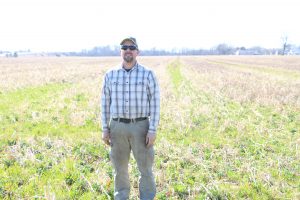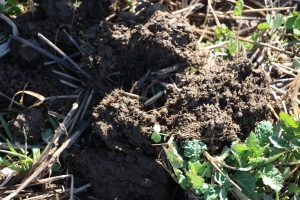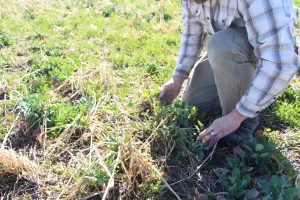Agronomy, Conservation, Homepage Slider, Water Quality
Cover Crop Mixes, the more species the better
By Dusty Sonnenberg, CCA, Ohio Field Leader, a project of the Ohio Soybean Council and soybean check-off.
It is one thing for a young person to begin farming and earn the respect of their neighbors as a “good farmer”. It is another thing to farm, implementing practices very different from the norms in the area, and still earn respect. For Matt Burkholder of Allen County being a young farmer and exploring a production system that was not well understood in the area, (cover crops), was just that.

“I started farming in 2006 using full tillage. In 2009 I planted my first cover crop,” said Burkholder. “I planted a field to annual king rye, which is not a VNS variety, so that next spring was very interesting. Multiple farmers stopped to lend advice, even though they had never planted a cover crop. I reached out to the two coops that I had purchased the seed from, and they were not able to provide much guidance either. At that point I really could have used a mentor that had experience with cover crops and their management and termination. I planted the soybeans and then sprayed to terminate the cover crop the following day. Fortunately, it all worked out.”
Starting small and taking time to learn is important. “After the first year experimenting with the annual king rye, I took a year off to re-evaluate what I wanted to achieve with cover crops, then slowly went back into raising cover crops, planting cereal rye for a few years as a single species in order to get a better feel for it,” said Burkholder. Today Burkholder is growing multiple cover crop mixes, including a 58-acre field that had a 16 species cover crop blend, combining with mostly legumes, and then some annual and cereal rye. “We took a wheat field, and baled the straw, let the volunteer wheat come and sprayed it off, and then drilled it in at about 32 pounds per acre. We will no-till corn into it,” said Burkholder.
Over time, cover crops have the ability to change the soil structure and the growing environment. “We are far enough along in the system, that this year we will not have the traditional fungicides and insecticides on our seed. We will only have the inoculation,” said Burkholder. “We do not use any granular fertilizer on or soybeans because I don’t want the salts. We only do foliar and add a gallon of molasses each trip. We foliar feed the crop with the first herbicide application, and then follow-up about a month to a month and a half later with a second foliar feed application. The molasses seems to help the growing plant cells, and also feed the microbes in the soil and on the residue.
Getting into cover crops from scratch can be an evolution of equipment. “My first-year farming, I only had a 30” row corn planter, and did not have a drill, so raising wheat was not an option,” said Burkholder. “A few years later I purchased a drill so we were able to add wheat to the rotation. I can now drill wheat and my beans as well as cover crops following the wheat. We also aerial seed cover crops into the soybeans.”
Aerial seeding cover crops is also a learning experience. “I like to aerial seed cover crops into the beans when the green tint changes in the beans,” said Burkholder. “A farmer with experience in aerial seeding over by Fostoria taught me that. He said when the green tint changes, that is when you do fly it on. I thought it was a lot of green out there, but anytime I have gone later, when the beans were more of a yellow color, I did not have as good of results as seeding when they just started to change.”
Seeding rates will vary with the method of seeding, and also what the end goals of the farmer are. “I aerial seed my rye cover crops at 100 pounds per acre. One reason for the high rate is because I grow Non-GMO soybeans and I need to have as much residue and biomass as possible,” said Burkholder. “I also plant 7.5” row soybeans so they canopy earlier. For corn, I fly the cover crop on at the end of August or beginning of September depending on the situation. It works well to fly it on since I also have a full-time job and do not have time to drill 400 acres with a 15-foot drill.  This also allows for something to be growing by harvest time, and hopefully take up any moisture and root mass to ride on top of. It is also building our soil organic matter levels.”
This also allows for something to be growing by harvest time, and hopefully take up any moisture and root mass to ride on top of. It is also building our soil organic matter levels.”
Burkholder participated in The Nature Conservancy’s “Farmer Advocates for Conservation Program” and hopes to be able to mentor other farmers wanting to learn from his experience about cover crops. “I could have used a mentor numerous times along the way,” said Burkholder. “My advice to anyone interested in growing cover crops is to take them seriously and plant them with the same attention that you would your corn or soybeans. Also be sure to order your seed early.”